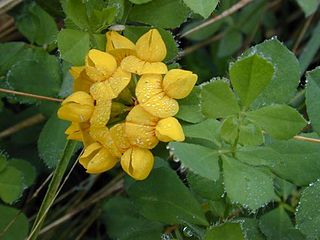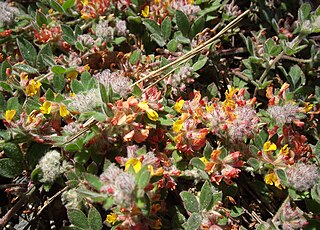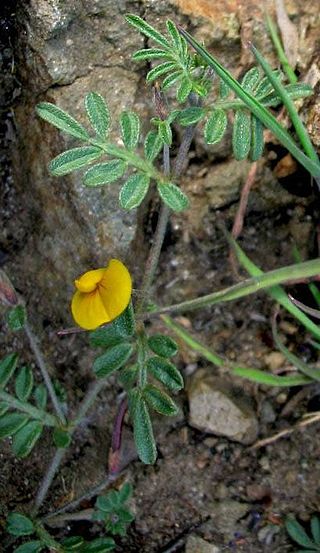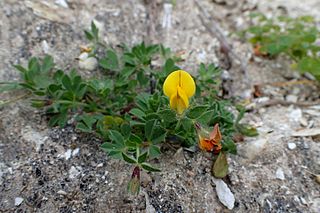
Lotus, a latinization of Greek lōtos, is a genus of flowering plants that includes most bird's-foot trefoils and deervetches and contains many dozens of species distributed in the eastern hemisphere, including Africa, Europe, western, southern, and eastern Asia, and Australia and New Guinea. Depending on the taxonomic authority, roughly between 70 and 150 are accepted. Lotus is a genus of legumes and its members are adapted to a wide range of habitats, from coastal environments to high elevations.

Lotus corniculatus is a flowering plant in the pea family Fabaceae, native to grasslands in temperate Eurasia and North Africa. Common names include common bird's-foot trefoil, eggs and bacon, birdsfoot deervetch, and just bird's-foot trefoil, though the latter name is often also applied to other members of the genus.

Lotus tenuis is a flowering plant of the pea family Fabaceae, native to western and southern Europe and southwest Asia. Some botanists treat it as a subspecies of Lotus corniculatus, as L. corniculatus subsp. tenuifolius.

Lotus pedunculatus, the big trefoil, greater bird's-foot-trefoil or marsh bird's-foot trefoil, is a member of the pea family (Fabaceae).

Acmispon argophyllus, synonym Lotus argophyllus, is a species of legume native to California and northwest Mexico. It is known by the common name silver bird's-foot trefoil or silver lotus.

Acmispon heermannii is a species of flowering plant in the family Fabaceae known by the common names Heermann's bird's-foot trefoil and Heermann's lotus. It is native to the coastal plains, canyons, and mountains of California and Baja California, where it is known from several types of oceanside and inland habitat. It is a mat-forming perennial herb spreading straight stems along the ground. It is lined with leaves made up of several hairy oval leaflets. The inflorescence is a cluster of 3 to 8 flowers each up to about a centimeter long. The petals are yellow, often with dark lobes. The fruit is a curved, beaked legume pod.

Acmispon maritimus, synonym Lotus salsuginosus, is a species of legume native to Arizona, California and northwestern Mexico. It is known by the common name coastal bird's-foot trefoil. It grows in many types of mountain, desert, and scrub habitat, not necessarily near the coast. It is an annual herb quite variable in morphology, from petite to bushy, hairless to roughly hairy, and prostrate to erect in form. The slender stems are lined with leaves each made up of pairs of leaflets variable in shape and size. The inflorescence is a small array of 1 to 4 yellow flowers, each up to a centimeter long or so. The elongated flower corolla emerges from a tubular calyx of sepals. The fruit is a legume pod up to 3 centimeters long. Laboratory studies have shown this species, which occurs in wildfire-prone habitat such as chaparral, to have an increased rate of seed germination after exposure to heat.

Acmispon strigosus, synonyms Lotus strigosus and Ottleya strigosa, is a flowering plant in the pea family (Fabaceae), native to the southwestern United States and northern Mexico. It is known as stiff-haired lotus or strigose bird's-foot trefoil.

Lotus cytisoides is a species of perennial herb in the family Fabaceae. They have a self-supporting growth form and compound, broad leaves. Individuals can grow to 0.11 m.

Lotus edulis is a species of annual herb in the family Fabaceae. They have a self-supporting growth form and compound, broad leaves. Individuals can grow to 0.14 m.

Lotus ornithopodioides, the southern bird's foot trefoil, is a species of annual herb in the family Fabaceae. They have a self-supporting growth form and compound, broad leaves. Individuals can grow to 5 cm tall.
Lotus aegaeus is a perennial plant in the family Fabaceae and genus Lotus native from the Balkan Peninsula to Northwestern Iran.
Lotus longisiliquosus is a plant in the Lotus genus that is native to The Mediterranean.
Lotus × medioximus is a hybrid plant in the Lotus genus native to Europe.
Lotus angustissimus, the slender bird's foot trefoil, is a plant in the genus Lotus. It has a wide distribution, from Macaronesia to Xinjiang in China.
Lotus frondosus is a perennial plant from the Lotus genus ranging from E. Ukraine to Caucasus and Mongolia.
Lotus germanicus is a species of plant in the genus Lotus native to Central and Southeastern Europe.
Lotus goetzei is a plant in the genus Lotus ranging from Ethiopia to S.southern Tropical Africa.
Lotus hebecarpus is an annual to perennial plant in the genus Lotus ranging from NE Sudan to Djibouti.
Lotus holosericeus is a plant in the genus Lotus endemic to the Canary Islands.










